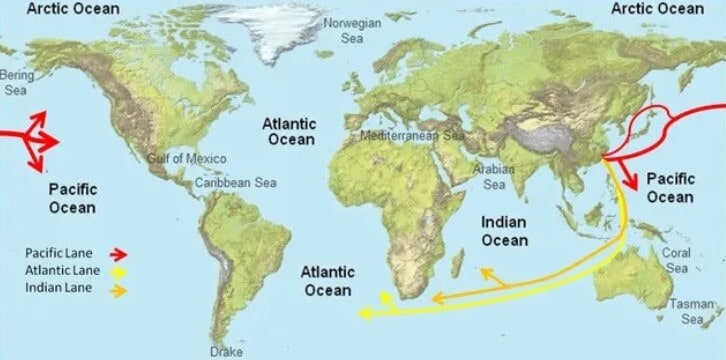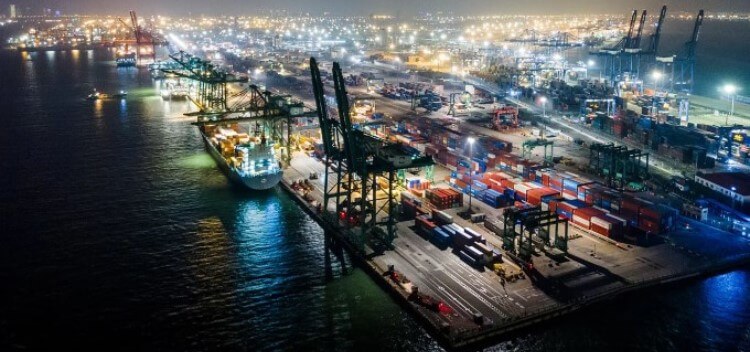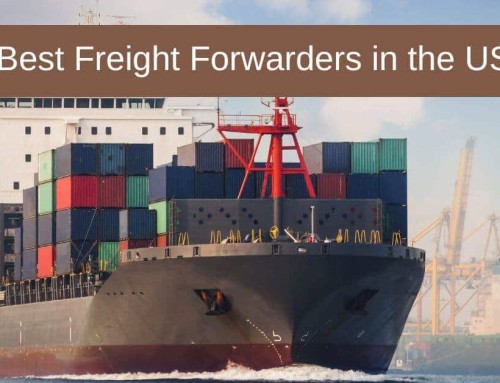Shipping Route from China to USA

Even with trade disputes, the United States remains China’s biggest export market. Together, they make the biggest international trade partners in the world. The most common way of shipping goods between these two countries is by Sea. You should have a sound knowledge of the sea routes because it affects your shipping time and costs. In this article, we’ll walk you through the major shipping routes from China to the USA and explain factors to consider before making your next shipment.
1. Major Shipping Routes from China to the USA.
There is no one single route to ship from China to the USA. This is because the USA is a huge country and one of the few countries with extensive coastlines on the Pacific and Atlantic oceans. Goods shipped to the USA may be shipped to the East or West coastline. They require different routes, distances, and shipping times. This is why we usually categorize shipping to the USA under the East and West Coast routes.
West Coast Routes
“The west coast of America is an essential economic gateway for the country. According to the U.S. Chamber of Commerce, about 50% of imports to the USA come in through the West Coast.” Two of America’s largest and busiest ports, the Port of Los Angeles and the Port of Long Beach, lie on the West Coast in California. Other ports on this coast include San Diego, Hueneme, Oakland, and Seattle-Tacoma ports. They are all well connected by road and rail to other interior regions of the USA.
China shipping to the West Coast is pretty straightforward and faster than other routes. The major shipping routes are:
1. Pacific Route (US West Coast)
It is the most commonly used route for shipments from China to the USA. Ships leaving Chinese ports like Shanghai, Shenzhen, Ningbo, and Xiamen travel through the East China Sea, go northwards through the Sea of Japan and the Okhotsk Sea, and enter the North Pacific Ocean. They arrive at West Coast ports like Los Angeles, Long Beach, Seattle, and Oakland. From there, you can transport cargo by rail or truck to the East Coast.
Distance & Transit Time:
The Pacific route covers about 6,000–7,200 nautical miles, depending on the two ports involved. It is the fastest way to ship from China to America, with goods arriving within 15 to 25 days.
Advantages:
- Fastest sea route from China to the USA.
- Ideal for time-sensitive deliveries.
- Shorter time means less costs on bulky shipments.
Considerations:
Major ports like Los Angeles and Long Beach are very busy and often congested, especially during peak seasons. As a result, your goods may be delayed during clearance, and you may incur additional costs. Your shipping through this route might also be more expensive because of the high demand for West Coast ports.

East Coast Routes
Goods shipped to the East Coast of the USA generally take longer to arrive from China. Major ports on this coastline are the ports of New York, Savannah, and Miami. Let’s see the popular routes from China to the East Coast.
2. Panama Canal Route
Goods are shipped from ports like Shanghai, Qingdao, and Ningbo, cross the Pacific, and travel through the Panama Canal. Ships exit the canal to enter the Atlantic Ocean and then arrive at US East Coast ports like New York, Savannah, Charleston, and Miami.
Distance & Transit Time:
This route takes around 35 to 45 days due to the additional distance (11,000-13,000 nautical miles) and the use of the Panama Canal.
Advantages:
- Provides direct access to East Coast markets
- One of the most effective routes to the US East Coast.
Considerations:
The Panama Canal route is much slower than the Pacific route and, as such, is not the best for urgent shipments. The cost of passing through the Panama Canal may also hike your shipping expenses. You should weigh your options to determine whether it’s better to ship first to the West Coast and use Air, truck, or Rail to transport to the Eastern markets.
3. Suez Canal Route
The Suez Canal is an alternative but less common route to the Panama Canal for East Coast shipments. However, the canal is narrow and busy, so ships only take this path when the schedule allows or when special cargo needs require it.
China ships on this route begin from Shanghai, Ningbo, or Qingdao in China, travel south through the Indian Ocean, then sail through the Suez Canal in Egypt and cross the Atlantic Ocean to arrive at New York, Baltimore, or Savannah ports.
Distance & Transit Time:
This route takes even longer than the Panama Canal route, usually about 40 to 50 days, with a distance of about 15,000 nautical miles.
Advantages:
- Useful for bypassing congestion at the Panama Canal
- Flexibility for cargo requiring special handling
- Allows access to European markets
Considerations:
As we already stated, this route has a much longer transit time. Although it has cheaper tolls than the Panama Canal, you’ll still incur higher fees shipping through this route. You should also know that the Suez Canal region is prone to political instability and fighting, which can disrupt your shipments.
4. Gulf Coast Route (US South and Gulf States)
The Gulf Coast route primarily serves southern ports like Houston, New Orleans, and Miami. Your goods will leave from the same Chinese ports and follow either the Pacific or Atlantic routes. It takes an average of 26 to 35 days.
Advantages:
- Great for shipping to the southern USA, like Texas and Florida.
- Ports on the Gulf Coast, like Houston, are less congested.
Considerations:
Gulf Coast ports have less shipping volume than the West and East Coast ports, which means fewer shipping options and carriers available. States in this region are also more prone to hurricanes and heavy storms, which affects the movement of your goods. You may be better served shipping to the East coast and then transporting it from there by rail or truck.
2. Major Ports in China and the USA

Major Ports in China
- Port of Shanghai: The Port of Shanghai is the world’s largest port in terms of cargo tonnage, with over 49 million TEUs handled in 2023. It’s so important to China trade that it serves one-fourth of its foreign trade. The port has advanced infrastructure, 125 berths, and can handle more than 2,000 ships monthly. Its proximity to major Chinese industrial regions makes it a prime location for export and import operations.
- Ningbo-Zhoushan Port: This mega port handled over 35.3 million TEU in 2023. It is home to over 60 deep water berths for 10,000 tons and more.
- Port of Shenzhen: Located in the Guangdong Province, this port remains one of the busiest in the world, handling over 27 million TEUs annually.
- Port of Guangzhou: It is one of China’s oldest and largest ports, handling over 23 million TEUs annually. It is located in Guangzhou, Guangdong Province.
- Port of Qingdao: It is located in Shandong Province on the Yellow Sea and connects northern China to huge markets in Japan, South Korea, and other Asia-Pacific countries. It handled over 26 million TEUs in 2023.
- Port of Tianjin: This is the largest port in northern China and serves as a gateway to Beijing. In 2023, it handled over 21 million TEUs.
Major Ports in the USA
- Port of Los Angeles: The West Coast port of Los Angeles, located in California, is the busiest port in the USA. The port’s extensive infrastructure and rail networks allow it to distribute goods nationwide and handle more than 9 million TEUs annually.
- Port of Long Beach: It is adjacent to Los Angeles port, this port also handles around 9 million TEUs per year.
- Port of New York and New Jersey: They’re the largest ports on the East Coast. They handle over 9 million TEUs annually and are critical for imports from China and Europe.
- Port of Savannah- Located in Georgia, it is one of the fastest-growing ports in the USA, handling over 5 million TEUs annually. Its strategic location makes it a preferred choice for shipping to the southeastern United States.
- Port of Houston: This Texas port is the largest in the Gulf of Mexico, handling around 4 million TEUs annually.
3. Transit Time from China to the USA
Below, we’ve compiled the average shipping times between the major shipping ports in China and the USA. This is by no means a definitive statement, but it should give you an idea of what to expect.
| Chinese Port | USA Port | Transit Time |
|---|---|---|
| Ningbo | Houston | 34 – 37 days |
| New York | 29 – 34 days | |
| Los Angeles | 15 – 20 days | |
| Shanghai | Houston | 35 – 46 days |
| New York | 30 – 35 days | |
| Los Angeles | 18 – 23 days | |
| Shenzhen | Houston | 31 – 34 days |
| New York | 25 – 30 days | |
| Los Angeles | 18 – 23 days | |
| Qingdao | Houston | 33 – 40 days |
| New York | 36 – 40 days | |
| Los Angeles | 20 – 23 days |
4. Factors to consider before choosing a China to USA Shipping Route
Now, you understand the various shipping routes and times from China to the USA. Choosing the routes isn’t always a straightforward decision. In some cases, it is better to ship goods to a West Coast port and then use trucks, rail, or air to transport them to the East Coast, rather than shipping them to the East Coast directly. Let’s see the major considerations before choosing a route.
- Cargo destination in the USA: The final destination of your goods influences the destination port you choose and, in turn, the shipping route. If you can help it, choose a port closer to the final destination as much as possible to reduce inland transportation time and costs. As we’ve explained, the Pacific route, which terminates at the western ports of Los Angeles, Long Beach, or Seattle, better serves goods destined for the west and central states. For goods headed to the eastern or southeastern regions of the USA, the Panama Canal may be your best bet. Sometimes, you may also need to consider the port of origin in China to make the best decisions.
- Transit Time: How urgently you need your goods delivered also determines your route. When time-sensitive goods are involved, it’s preferable to take the Pacific route to the western ports. From there, you can use air freight, truck, or rail freight to move your goods quickly to your final destination. If time is not a serious consideration for you, then you may explore other routes.
- Cost of Shipping: If you’re familiar with international shipping, you must know that the shipping method, shipping route, and cargo size mainly determine your shipping costs. Aside from the distance, certain routes incur additional fees, e.g., the Panama Canal incurs additional fees due to canal transit charges. If you have a low budget, consider the more direct routes to the West Coast, then move from there.
- Cargo Type: Perishable or high-value goods might require faster transit times, restricting you to the Pacific route. Cargo with specialized requirements, such as oil or hazardous materials, may also require specific routes and vessel types that certain ports cannot handle at that moment.
- Port Congestion: West Coast ports like Los Angeles and Long Beach are some of the busiest in the world and can experience heavy congestion, especially in peak shipping seasons. In fact, many importers sometimes prefer taking the longer routes to the East Coast ports to avoid this congestion.
- Seasonal Weather and Political Risks: We mentioned that certain routes are more prone to hurricanes, storms, and political instability during certain times of the year. Consider these factors when choosing a route.
- Port Connectivity: If your cargo destination is further inland, you must consider the rail or road connectivity from the port to the final destination. Some ports have better infrastructural connectivity than others and determine how much easier your shipping would be.
- Environmental Sustainability: The world is becoming more concerned about carbon emissions and sustainability. Longer routes like the Panama or Suez Canal have higher carbon emissions. If your business is concerned with reducing carbon footprints, consider the shorter Pacific route.
- Freight Forwarder Expertise: Finally, your freight forwarder knows the best routes for your shipment, and you should trust them. They’ll consider the ease of clearance, shipping cost negotiations, weather, congestion, etc., before recommending a route for you.
5. Shipping from China to the USA with Winsky
When choosing the best shipping route from China to the USA, you’ll need to balance factors like cost, transit time, cargo type, port accessibility, etc. You need a reputable China freight forwarder to make your shipping much easier. And that’s where we come in. With 15 years shipping from China to the USA, Winsky offers Express Shipping, Sea Freight, Air Freight, and door-to-door delivery. We’ll help you with everything, from import and export clearance to delivering your goods at your doorstep. Our prices are competitive, and our logistics process is smooth and fast. Contact Winsky today for an excellent shipping experience.
Conclusion
This article examined the Pacific, the Panama Canal, and the Suez Canal routes from China to the USA. Understanding these routes will help you plan your next shipment in the best way possible. Remember that each route has its trade-offs, and working with a freight forwarder will help you make the best decision. When you’re ready to ship, reach out to Winsky for a quote.



Leave A Comment